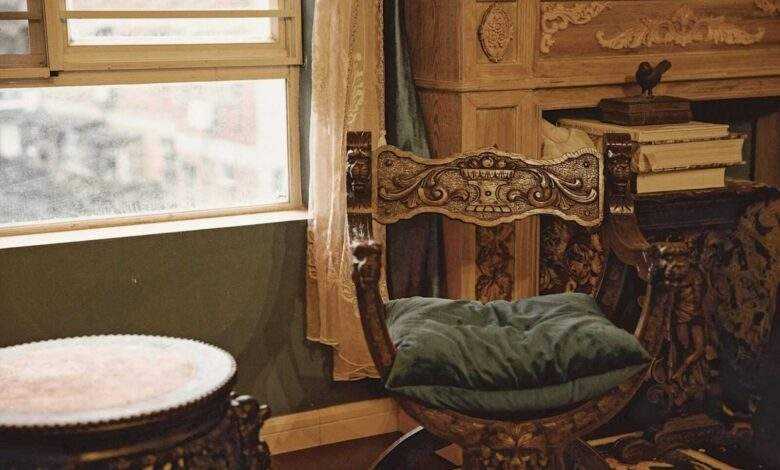Eco-Friendly Furniture: 5 Sustainable Ways to Furnish Your Home

Table of Contents
In today’s world of sustainable living, the appeal of Eco-Friendly Furniture and the art of upcycling have surged in popularity. Whether you’re furnishing a new home or revamping your current decor, embracing secondhand style not only reduces environmental impact but also offers creative, budget-friendly decorating solutions. This detailed guide explores the benefits of choosing eco-friendly furniture and provides practical tips for finding, transforming, and integrating secondhand pieces into your home.
The Allure of Secondhand Furniture
Secondhand furniture holds a unique charm that often surpasses new items. Imagine stumbling upon a vintage dresser with intricate woodwork or a mid-century modern armchair that adds character to your living room. Beyond affordability, secondhand furniture carries a history that resonates with homeowners seeking authenticity and sustainability. By choosing pre-owned pieces, you contribute to reducing waste and minimizing the environmental footprint associated with furniture production.
Benefits of Choosing Secondhand
- Cost-Effectiveness: Secondhand furniture is typically more affordable than new items, allowing you to furnish your home stylishly on a budget. Example: Purchasing a gently-used dining table from a local thrift store can cost significantly less than buying a similar new table from a retail store.
- Unique Finds: Each piece of secondhand furniture tells a story and brings a sense of individuality to your space, unlike mass-produced items. Example: Finding a retro lamp or a rustic bookshelf at a garage sale adds a personal touch that enhances your home’s decor.
- Environmental Impact: Opting for secondhand reduces the demand for new furniture production, thereby conserving resources and reducing greenhouse gas emissions. Example: By purchasing a secondhand sofa instead of a new one, you help minimize the carbon footprint associated with manufacturing and shipping new furniture.
Sustainable Living and Decor
- Promoting Reuse: Embracing secondhand furniture aligns with principles of sustainability by extending the lifecycle of existing materials. Example: Upcycling an old dresser into a bathroom vanity not only reduces waste but also adds a unique focal point to your home.
- Supporting Local Communities: Shopping at thrift stores, consignment shops, and local markets supports local businesses and charitable organizations. Example: Donating furniture to a community reuse center provides affordable options for others while benefiting community programs.
- Educational Value: Exploring secondhand markets can be educational, offering insights into craftsmanship, historical styles, and the durability of older furniture. Example: Learning about different wood types and furniture styles can empower homeowners to make informed choices about their purchases.
Finding Eco-Friendly Furniture
Thrift Stores and Consignment Shops
Thrifting Tips: Thrift stores like Goodwill and Salvation Army offer a wide range of furniture at affordable prices. Look for well-maintained pieces with sturdy construction and classic designs. Consider visiting regularly as inventory changes frequently.
Example: Goodwill Industries provides furniture and home goods at reasonable prices, with proceeds supporting job training programs for individuals in need.
Relevant Resources:
- Goodwill: Find a store
- Salvation Army: Explore furniture and home goods
Online Marketplaces
Navigating Online Platforms: Websites like Facebook Marketplace, Craigslist, and eBay offer extensive selections of secondhand furniture. Use specific search terms and filters to find local sellers and arrange in-person inspections before making purchases.
Example: Facebook Marketplace allows users to browse furniture listings by location, making it easy to find items available nearby.
Relevant Resources:
- Facebook Marketplace: Browse local listings
- Craigslist: Explore furniture listings
Estate Sales and Auctions
Unearthing Hidden Treasures: Estate sales and auctions are ideal for discovering unique and high-quality furniture pieces. Attend local events or browse online listings to find vintage and collectible items.
Example: Local estate sales often feature well-preserved furniture with historical significance, offering a glimpse into past design trends.
Relevant Resources:
- EstateSales.net: Find estate sales near you
- AuctionZip: Search for furniture auctions
Local Buy/Sell/Trade Groups
Community Engagement: Joining local buy/sell/trade groups on social media platforms connects you with neighbors selling pre-loved furniture. These groups often feature unique pieces not found elsewhere.
Example: Neighborhood Facebook groups facilitate transactions and exchanges within local communities, promoting sustainable shopping practices.
Relevant Resources:
- Facebook Groups: Join local buy/sell/trade groups
Furniture Banks and Donation Centers
Giving Back: Donating unwanted furniture to furniture banks or charity donation centers supports community initiatives and reduces landfill waste. Some centers also offer affordable options for purchasing secondhand furniture.
Example: Habitat for Humanity’s ReStores sell donated furniture and building materials to fund housing projects for low-income families.
Relevant Resources:
- Habitat for Humanity ReStores: Find a ReStore near you
Upcycling Projects
Introduction to Upcycling
Creativity Unleashed: Upcycling involves transforming old or discarded furniture into new, functional pieces through creative techniques. From refinishing surfaces to repurposing materials, upcycling allows for personalized decor while reducing waste.
Example: Repurposing wooden pallets into a coffee table or bookshelf demonstrates the versatility of upcycling in home design.
Furniture Restoration Techniques
Refinishing Basics: Assess the condition of secondhand furniture and identify areas for improvement. Sanding, staining, or painting can revive worn surfaces and enhance aesthetic appeal.
Example: Using eco-friendly paints and finishes minimizes environmental impact while preserving the natural beauty of wood furniture.
Relevant Resources:
- Explore HGTV’s guide on furniture refinishing techniques
DIY Projects with Secondhand Furniture
Creative Transformations: Convert secondhand finds into personalized pieces through DIY projects. From reupholstering chairs to creating storage solutions, DIY allows for customizing decor to suit individual tastes.
Example: Turning an old dresser into a kitchen island adds functionality and style to your home while reducing waste.
Advanced Upcycling Techniques
Specialized Skills: Explore advanced techniques such as decoupage, stencil painting, or woodworking for intricate upcycling projects. These methods add artistic flair and unique character to furniture pieces.
Example: Incorporating mosaic tiles into a tabletop or cabinet door showcases advanced upcycling skills and craftsmanship.
Upcycling Challenges and Solutions
Overcoming Obstacles: Address common challenges in upcycling, such as repairing structural damage or matching existing decor styles. Provide practical solutions to ensure successful furniture transformations.
Example: Repairing loose joints or replacing hardware can extend the lifespan of secondhand furniture and enhance its functionality.
Sustainability Tips
Choosing Eco-Friendly Materials
Sustainable Choices: Opt for furniture made from reclaimed wood, bamboo, or recycled materials. These options minimize environmental impact and add unique textures to your home decor.
Example: Choosing a bamboo dining set over conventional wood reduces deforestation and promotes sustainable forestry practices.
Avoiding Harmful Chemicals
Healthier Living: Select furniture free from harmful chemicals such as formaldehyde or VOCs. Look for certifications like Greenguard or Cradle to Cradle to ensure products meet stringent health and environmental standards.
Example: Upholstered furniture certified as low-emission contributes to healthier indoor air quality by reducing off-gassing.
Energy-Efficient Appliances
Whole-House Approach: Upgrade to energy-efficient appliances and lighting solutions to reduce household energy consumption. LED light bulbs, Energy Star-rated appliances, and programmable thermostats offer long-term savings and environmental benefits.
Example: Installing LED bulbs throughout your home reduces electricity usage and lowers utility bills over time.
Water Conservation Techniques
Conserving Resources: Implement water-saving strategies such as installing low-flow faucets and showerheads, fixing leaks promptly, and incorporating drought-tolerant landscaping. These practices minimize water waste and support sustainable water management.
Example: Retrofitting faucets with aerators reduces water flow without compromising performance, saving gallons of water annually.
Renewable Energy Options
Exploring Alternatives: Consider renewable energy sources like solar panels or wind turbines to power your home sustainably. While initial costs may be higher, these investments offer long-term energy savings and reduce reliance on fossil fuels.
Example: Solar panel installations qualify for federal tax incentives and rebates, making them more affordable and accessible for homeowners.
Integrating Secondhand Style
Blending Old with New
Creating Harmony: Mix secondhand furniture with new decor pieces to achieve a balanced and cohesive interior design. Combine styles, textures, and colors to reflect personal preferences while creating visually appealing living spaces.
Example: Pairing a vintage leather sofa with modern accent chairs creates a stylish contrast that enhances the overall aesthetic of your living room.
Space Planning and Design
Optimizing Layouts: Consider the layout and functionality of each room when integrating secondhand furniture. Arrange pieces to maximize space and create comfortable living environments that accommodate daily activities.
Example: Positioning a secondhand dining table near natural light sources enhances dining experiences while reducing the need for artificial lighting during daytime.
Outdoor Living Spaces
Enhancing Exteriors: Extend secondhand style to outdoor areas with upcycled patio furniture, garden decor, and sustainable landscaping ideas. Choose weather-resistant materials and functional designs that withstand outdoor elements.
Example: Upcycling wooden pallets into outdoor seating with weather-resistant cushions creates a cozy and inviting outdoor retreat for family and friends.
Seasonal Decor Transitions
Versatile Design: Update decor seasonally with interchangeable accents and furniture pieces. Incorporate lightweight fabrics and natural elements during warmer months, and switch to cozy textiles and warm colors for colder seasons. This approach allows for flexible decorating options that reflect changing seasons.
Example: Using removable slipcovers on secondhand sofas allows for easy cleaning and seasonal color changes to match interior decor themes.
Family-Friendly Solutions
Practical Considerations: Choose durable and child-friendly secondhand furniture options for family homes. Prioritize safety features, ease of maintenance, and versatility when selecting pieces that accommodate the needs of every family member.
Example: Opting for solid wood furniture with rounded edges reduces the risk of injuries and enhances durability in high-traffic areas of the home.
Embracing secondhand style and upcycling projects not only enhances your home’s aesthetic appeal but also contributes to sustainable living practices. By choosing eco-friendly furniture and engaging in creative DIY projects, you promote resource conservation and reduce environmental impact. Whether you’re furnishing a new home or revitalizing your current space, secondhand style offers endless opportunities for budget-friendly, environmentally conscious decorating.
-
Why should I choose secondhand furniture over new?
Choosing secondhand furniture not only saves money but also reduces environmental impact by extending the lifecycle of existing materials. Each piece carries a unique history and character that adds charm to your home.
-
How can I ensure the quality of secondhand furniture?
Inspect secondhand furniture for structural integrity, signs of wear, and functionality before purchasing. Look for well-maintained pieces with durable materials to ensure long-term satisfaction.
-
What are the benefits of upcycling furniture?
Upcycling allows you to unleash creativity by transforming old furniture into new, personalized pieces. It reduces waste, promotes sustainability, and gives you the opportunity to create unique decor items.
-
How can I start upcycling furniture if I’m not crafty?
Begin with simple upcycling projects such as repainting a dresser or reupholstering a chair. Many online resources offer step-by-step guides and inspiration for beginners.
-
What are some eco-friendly materials for furniture?
Opt for furniture made from reclaimed wood, bamboo, or recycled materials. These options minimize environmental impact and offer unique textures and finishes for your home decor.
-
How can I incorporate secondhand furniture into modern decor styles?
Mix and match secondhand pieces with contemporary decor elements to create a balanced and cohesive look. Focus on complementing textures, colors, and styles to achieve a harmonious blend.
-
What are the challenges of upcycling furniture, and how can I overcome them?
Common challenges in upcycling include repairing damage, matching existing decor, and mastering new techniques. Research solutions, seek guidance from experts, and practice patience throughout the process.
-
How can I ensure my upcycled furniture is safe and durable?
Use quality materials, follow proper techniques, and prioritize safety measures when upcycling furniture. Ensure structural stability and consider using eco-friendly paints and finishes for a healthier home environment.
-
Where can I donate or recycle old furniture responsibly?
Donate unwanted furniture to local charity organizations, furniture banks, or participate in community recycling programs to support sustainability efforts and reduce landfill waste.
-
How can I make my entire home more eco-friendly?
Incorporate energy-efficient appliances, sustainable materials, and water-saving fixtures into your home. Practice mindful consumption, reduce waste, and explore renewable energy options for long-term sustainability.








